Related Research Articles

Yoko Ono is a Japanese multimedia artist, singer, songwriter, and peace activist. Her work also encompasses performance art and filmmaking.
The Plastic Ono Band was a rock band formed by John Lennon and Yoko Ono in 1969 for their collaborative and solo projects.
Anthony D. "Tony" Cox is an American film producer and art promoter. He is a former husband of Yoko Ono.
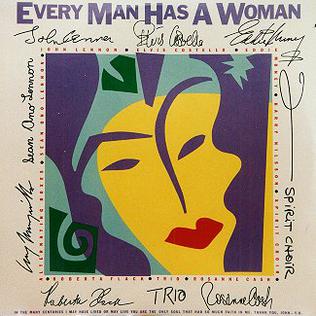
Every Man Has a Woman is a tribute album to Yoko Ono for her 50th birthday. It contains covers of her songs from the albums Approximately Infinite Universe (1973), Double Fantasy (1980), Season of Glass (1981), and It's Alright (1982). The album was purportedly one of John Lennon's projects, but he died before he could see its completion. The liner notes for the vinyl LP feature an essay by Ono entitled "A Crystal Ball".

Season of Glass is the fifth studio album by Yoko Ono, her first solo recording after the murder of her husband John Lennon. Season of Glass, released in 1981, reached #49 on the Billboard 200 Album Chart, making it Ono's highest-charting solo album to date.

Fly is the second album by Yoko Ono, released in 1971. Co-produced by Ono and John Lennon, the original release was a complete avant-garde/Fluxus package in a gatefold sleeve that came with a full-size poster and a postcard to order Ono's 1964 book Grapefruit. Notable songs include the singles "Midsummer New York" and "Mrs. Lennon", "Hirake" and "Don't Worry, Kyoko ", that was dedicated to Ono's daughter Kyoko Cox. "Airmale", that benefits from the automated noise music machines of Fluxus musician Joe Jones, is the soundtrack to Lennon's film Erection, showing a building being erected in time lapsed photography, while "Fly" is the soundtrack to Lennon and Ono's 1970 film Fly. The entire side three of this LP has Ono performing with various automated sound-machines created by Joe Jones pictured in the gatefold.

Indica Gallery was a counterculture art gallery in Mason's Yard, St James's, London from 1965 to 1967, in the basement of the Indica Bookshop. John Dunbar, Peter Asher, and Barry Miles owned it, and Paul McCartney supported it and hosted a show of Yoko Ono's work in November 1966, at which Ono met John Lennon.
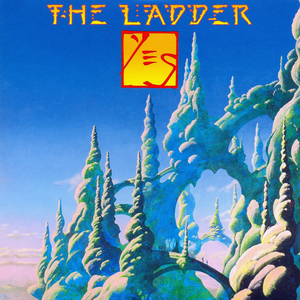
The Ladder is the eighteenth studio album by the English progressive rock band Yes. It was released in September 1999 on Eagle Records and is their only studio album recorded with six full time members, following the addition of keyboardist Igor Khoroshev two years prior. The album originated in 1998 when the band visited Vancouver, Canada while touring their previous album, Open Your Eyes (1997). They met producer Bruce Fairbairn, who agreed to work with them on a follow-up album which was recorded at Armoury Studios. During the final recording and mixing sessions Fairbairn died unexpectedly of a heart attack, and Yes dedicated the album to him.

John Dunbar is a British artist, collector, and former gallerist, best known for his connections to the art and music scenes of the 1960s counterculture.

Iain Stewart Macmillan was the Scottish photographer famous for taking the cover photograph for the Beatles' album Abbey Road in 1969. He grew up in Scotland, then moved to London to become a professional photographer. He used a photo of Yoko Ono in a book that he published in 1966, and Ono invited him to photograph her exhibit at Indica Gallery. She introduced him to John Lennon, and Lennon invited him to photograph the cover for Abbey Road. He worked with Lennon and Ono for several years, even staying for a while at their home in New York.
North Moore Street is a moderately trafficked street in TriBeCa, a neighborhood in the New York City borough of Manhattan. It runs roughly east–west between West Broadway and West Street. Automotive traffic is westbound only.
The 14 Hour Technicolor Dream was a concert held in the Great Hall of the Alexandra Palace, London, on 29 April 1967. The fund-raising concert for the counterculture paper International Times was organised by Barry Miles, John "Hoppy" Hopkins, David Howson, Mike McInnerney and Jack Henry Moore. It was part-documented by Peter Whitehead in a film called Tonite Let's All Make Love in London.
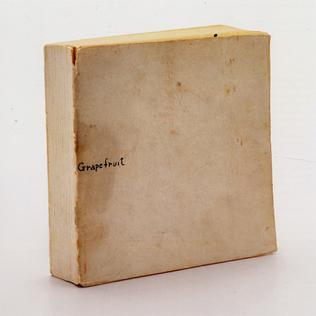
Grapefruit is an artist's book written by Yoko Ono, originally published in 1964. It has become famous as an early example of conceptual art, containing a series of "event scores" that replace the physical work of art – the traditional stock-in-trade of artists – with instructions that an individual may, or may not, wish to enact.
Grapefruit is one of the monuments of conceptual art of the early 1960s. She has a lyrical, poetic dimension that sets her apart from the other conceptual artists. Her approach to art was only made acceptable when [people] like Kosuth and Weiner came in and did virtually the same thing as Yoko, but made them respectable and collectible.
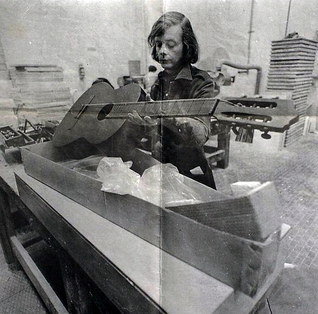
Joe Jones was an American avant-garde musician associated with Fluxus especially known for his creation of rhythmic music machines.

Spice Chess is an artist's multiple by the Japanese artist Takako Saito, while she was resident in the United States. Originally manufactured winter 1964–65, and offered for sale March 1965, the work is one of a famous series of disrupted chess sets referred to as Fluxchess or Flux Chess, made for George Maciunas' Fluxshop at his Canal Street loft, SoHo, New York City and later through his Fluxus Mail-Order Warehouse.
"Takako Saito engaged with Duchamp's practice but also with masculinist cold war metaphors by taking up chess as a subject of [her] art. Saito's fluxchess works... question the primacy of vision to chess, along with notions of perception and in aesthetic experience more generally.... Her "Smell Chess," "Sound Chess" and "Weight Chess" reworked the game of chess so that players would be forced to hone non-visual perception, such as the olfactory sense, tactility, and aurality, in order to follow chess rules." Claudia Mesch

Riflemaker is a contemporary art business and exhibition space in London specialising in exhibiting and representing emerging artists. The building is a historic gunmaker's workshop off Regent Street. Built in 1712, it is one of the oldest public buildings in the West End of London. Riflemaker is also a publisher of artists books and host of a variety of events including poetry, music, film events, talks, discussions and performances in the space.

David Hockney: A Bigger Picture was an exhibition at the Guggenheim Museum Bilbao from 15 May to 30 September 2012 of recent work of the English painter David Hockney. Consisting of paintings, collages and electronically produced art, the show took as its subject matter the East Riding of Yorkshire landscape.
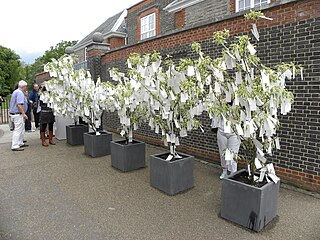
Wish Tree is an ongoing art installation series by Japanese artist Yoko Ono, started in 1996, in which a tree native to a site is planted under her direction. Viewers are usually invited to tie a written wish to the tree except during the winter months when a tree can be more vulnerable. Locations of the piece have included New York City, St. Louis, Wish Tree for Washington, DC, San Francisco, Pasadena, and Palo Alto, California, Tokyo, Venice, Paris, Dublin, London, Exeter, England, Finland and Buenos Aires, Argentina, Calgary.
Apple is a 1966 conceptual artwork by the Japanese artist Yoko Ono. The work is classified as Temporary art.

Half-A-Room is a 1967 conceptual artwork by the Japanese artist Yoko Ono.
References
- 1 2 3 4 "Ceiling Painting, Yes Painting". Guggenheim Museum Bilbao. Retrieved 2 January 2018.
- 1 2 Martha Buskirk (12 April 2012). Creative Enterprise: Contemporary Art Between Museum and Marketplace. A&C Black. p. 156. ISBN 978-1-4411-8820-5.
- 1 2 Nell Beram; Carolyn Boriss-Krimsky (1 February 2012). Yoko Ono: Collector of Skies. Abrams. ISBN 978-1-61312-513-7.
- ↑ Jean Yoon; Yōko Ono (2002). The Yoko Ono Project. Broken Jaw Press. p. 37. ISBN 978-1-55391-001-5.
- ↑ Jonathan Jones (journalist) (13 March 2014). "Yoko Ono show at Guggenheim shines light on pioneering conceptual artist". The Guardian. Retrieved 10 January 2018.
- ↑ "Ceiling Painting, Yes Painting". The Art Story. Retrieved 9 January 2018.
- ↑ James M. Harding (26 June 2012). Cutting Performances: Collage Events, Feminist Artists, and the American Avant-Garde. University of Michigan Press. p. 93. ISBN 0-472-03520-7.